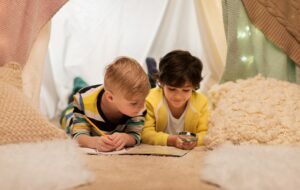We have been talking this month about ways to teach your children about giving and ways to make giving fun. With Giving Tuesday and the end of the year right around the corner, now is the time when a lot of non-profit organizations are asking for donations. Involving your child in the process of donating to a non-profit can be a great way to teach him about giving.
One of the first steps in the process is to talk to your child about why you donate to certain organizations. You probably have a few favorite places that you give money or time or other resources (like clothing and home goods) to during the year. Tell your child about those places and why you give. Try to be specific. For example, instead of telling your child that you give “…because it’s a good thing to do”, think about why you choose those places. Maybe you donate to the local animal shelter because you adopted a dog from a shelter when you were younger and that dog turned out to be one of your best friends. Or maybe you donate to the local food bank because you strongly believe that no one should ever go hungry. The more personal the reason, the more likely that it will make a lasting impression on your child. Studies show that such an impression can encourage your child to be more giving as she grows up.
You might also encourage your child to pick her own favorite organization for giving. Maybe he has been involved in activities at a local community agency or likes to go to a favorite park or wildlife area. Many of these places have non-profits attached to them that raise money to support the activities or maintain the parks and wildlife areas.
You can also help your child to pick a place to donate based on his or her interests. So if your child likes elephants, you could go online to find an organization that might help protect elephants from poachers. Or if your child really likes to read (or be read to), you could find an organization that donates books to kids.
And you and your child do not necessarily have to donate money. There are many ways to give your time or other resources locally. For example, at this time of year, many organizations sponsor toy or food drives for families in need. Your child could pick out a toy for another child.
Donating money, time, or resources can be a great family activity. And teaching your kids about and modeling giving makes it more likely that they will continue to be generous givers throughout their lives.
[divider type=”standard” text=”Go to top” full_width=”no” width=”1/1″ el_position=”first last”]
Image: © Sasi Ponchaisang | Dreamstime.com





